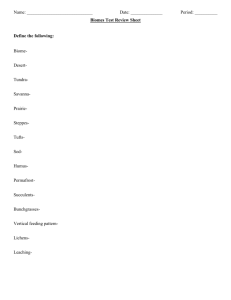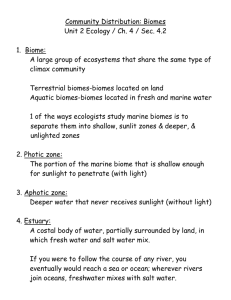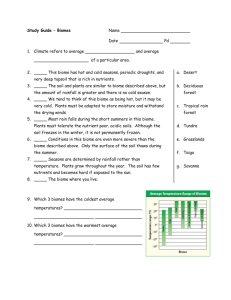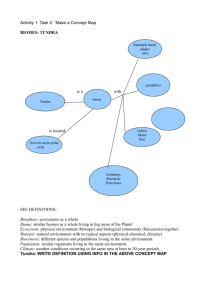biomes - Hopewell 7th Science
advertisement
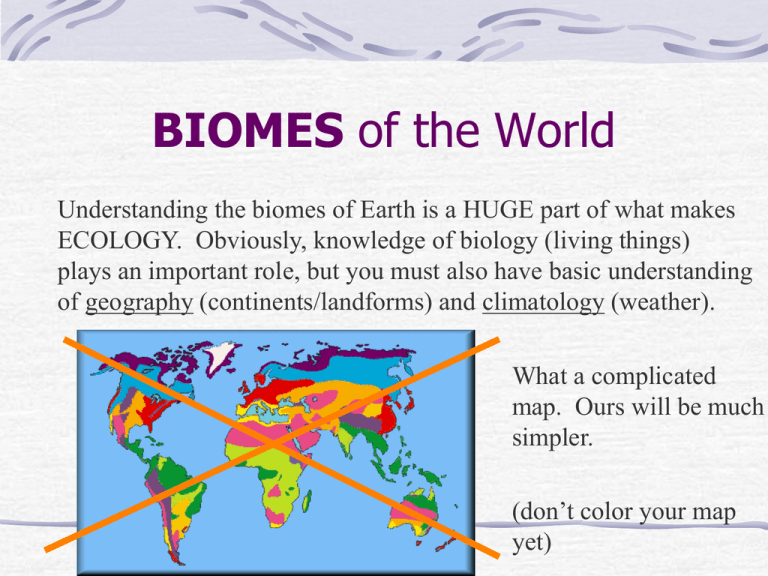
BIOMES of the World Understanding the biomes of Earth is a HUGE part of what makes ECOLOGY. Obviously, knowledge of biology (living things) plays an important role, but you must also have basic understanding of geography (continents/landforms) and climatology (weather). What a complicated map. Ours will be much simpler. (don’t color your map yet) So, What’s a Biome??? A BIOME is a large geographical area on Earth that features a unique set of plants & animals that are suited t o live there. It’s what makes a “desert” a “desert.” We could be picky and have over a dozen different Biomes to learn about, but let’s keep it simple. We’re going to study these six: Tundra Coniferous Forest (Taiga) Deciduous Forest (Temperate Forest) Grassland (Savanna) Desert Tropical Rain Forest One Important Thing to Remember: Look at our beautiful planet. It rules. We HAVE to remember, though, that the majority of Earth is covered in water. The amount of life in the rivers, lakes, seas, and oceans of the world make the amount of life on land look like an empty room. It’s more complicated than just saying “there’s a bunch of fish eating each other and a dolphin and seaweed and stuff, too.” From freshwater to saltwater to near-frozen oceans, the water of Earth is its own unique universe. Even MORE IMPORTANT to Remember As we go through these biomes, discussing what they’re like and what kind of organisms we find there, keep this in mind: The kinds of animals you find in a place on Earth usually depend on the kinds of plants that are there. The kinds of plants depend on the soil and climate of the place…the moisture, temperature, and soil. THAT’S THE THEME OF THIS WHOLE POWERPOINT. Animals depend on plants which depend on the climate & environment. Now, keep that last “theme” in mind & let’s get started You’ve got a paper with a map on the front: For each biome, you’ll gradually color in the Earth showing where those biomes can be found. You’ll fill in the info on the back as you work. Work efficiently, but take your time absorbing as much info as you can…this isn’t a race to just get done. The Tundra Biome (don’t write this stuff…this is just an overview of the biome) Near the most northern parts of Earth. Um, cold. Treeless, mostly frozen Low biodiversity (variety of living things) Northern Scandinavia & Siberia North American Tundra & coast of Greenland & Iceland. Create a color box key on or near the title of the biome. Color all area 1’s Pick a color (doesn’t need to be yellow) and try to match what you see here. 1 Now Flip your Map Over …and get ready to fill in the information in the chart. The title of each powerpoint slide will clue you in on which box to write in, and anything you need to copy will be in red text. First of all, write TUNDRA in the first “name” box. Climate & Soil of the Tundra Just look at where you finished coloring on your map. Those places are COLD. They receive such little direct sunlight that they are above freezing for only a few months of the year. Dang! Climate – Very little precipitation; (it doesn’t really snow that much. It just looks like it because the snow sticks around and doesn’t melt). Much ice/snow, very cold all year. It does get above freezing in Summertime, though. Soil – Permafrost – frozen most of year ( for plants) Slushy when thawed. Plants of the Tundra So, what kind of plants grow in a place where it’s frequently below zero, dark for half the year, with frozen soil? Brave plants. Very brave. The key here is that there are NO TREES in the true tundra. It’s too cold, too windy, with too-hard soil and not enough moisture to support forests. With just a few inches of thawed soil to grow in (during summers), you’re going to find small ground plants & grasses. These can sprout up quickly when it warms up in the Summers & reproduce in the little time available to them. Tundra Animals …and what kind of animals would live in such a place? Crazy, freaking crazy ones. But what kind of animals can even survive here? First, you’ve GOT to be able to make your own body heat, or you’re going to be frozen stiff. So count on finding warm-blooded birds & mammals. A coldblooded animal, like a crocodile, would die within minutes of being dumped in 30-below-zero weather. In the summers, though, the slushy, thawed soil provides great places for insects to lay eggs. The birds in the Tundra have a ton of food opportunities when the insects in summer start swarming around. Examples of Plant Life In these powerpoints, when I write: (P) and (A), that just stands for plants & animals. The small ground plants are mosses (P): Moss, lichen, grass Save room for animals, too. Lichen is a crusty, flaky organism that grows on rocks & trees. We have it here in Texas, too. Both the gray & yellowish stuff here Are lichens. Pronounce it: Like-uhn. Examples of Animal Life (A): Reindeer, Polar Bear, Goose Well, what’s left of the goose, anyway. That’s it for the Tundra Hopefully, you kept our THEME in mind as you filled out the chart for Tundra. We have polar bears & reindeer because of the kinds of plants available. We have the juicy little mosses & grasses the reindeer munch on due to the horrible soil and harsh climate of the Tundra. Animals depend on plants which depend on soil & climate. Now you’ve got the hang of this, so let’s go on to our next BIOME. Pick a new color. Coniferous Forest Biome Guess what? This biome has lots of trees! You didn’t already know that, though. Biggest trees on Earth Another cold biome (near Tundra) Did I mention the trees are big? Coniferous is pronounced: Kuh-niff-err-us Thick pine, fir & redwood forests of USA & Canada 1 2 Add to your key Taiga forests of Europe & Russia Climate & Soil of the Coniferous Forest This is a pretty cold biome in the northern parts of Earth The climate features medium rain/snow with long, cold winters and short summers. The soil is poor soil for plant life. The ground is smothered in needles that fall from the trees. These needles are SLOW to decay and don’t return their nutrients quickly to the soil. Pine needles carpeting the ground Plants of the Coniferous Forest Even though this is a cold, often snow-covered biome, there’s enough moisture available and the ground is thawed almost all year so that huge trees grow here. These are heavy conifer forests (trees w/ needles & cones). These trees, almost as soon as they sprout, act like they’re in a race to be the tallest around. They grow so tall, so fast, that it’s pretty dark on the forest floor. There are few small plants due to the lack of light and smothering effect of the bigger trees around them. These conifers have needles & cones instead of broad leaves and flowers. They are often hundreds (if not thousands) of years old and are usually evergreen, growing all through the winter. Animals in the Coniferous Forest Life here for animals is almost as hard as it is in the Tundra. Being a chilly biome, you’re still going to find mostly warm-blooded animals here, though a few reptiles/amphibians will be seen. The Winters are harsh. It snows a lot, and daylight hours are short. Many migrate or hibernate to get through the Winter without having to actively fight the environment. Hibernating ground squirrel Examples of Plant Life When you see the word “conifer,” think of the shaggy, needled trees that we typically think of around Christmas time. (P): Pine tree, Fir Tree, Redwood Tree California’s giant Sequoia trees General Sherman Most of the ancient sequoia trees in the California forest are named. The most impressive is a tree named General Sherman. It is Earth’s largest living organism—you could fit dozens of blue whales inside of it. Examples of Animal Life Most of the animals here have feathers or thick fur to keep warm. (A): Moose, wolf, grizzly So, that’s the Coniferous Forest. You can see that the warm-blooded animals and needlebearing trees have to deal with the extreme challenges of life in a snowy, dark forest world. Deciduous Forest Biome Yep. More trees. But this forest biome is more typical of what we’d call “the woods” around here. More “even” climate. More variety of plant life. More variety of animal life. Pronounce “deciduous”: Deh-si-joo-uhs Eastern Asia North Africa & Most of Europe Eastern Woodlands 6 Coast of Australia, New Zealand, Tasmania Add to your “key” Climate & Soil of the Deciduous Forest You can see from the map that we’ve worked our way farther away from the poles, so that we’re talking about places with 4 real seasons. Climate – These forests tend to enjoy good rainfall throughout the year. Soil – The leaves that fall to the ground tend to decay quickly, dumping nutrients into the ground. Thus, there is good soil for different plants. Plants in the Deciduous Forest What does “deciduous” mean, anyway? Basically, think of these as trees that: Have broad leaves that typically drop off in Autumn Have flowers which produce fruits with seeds Shut down for the Winter—they’d rather not try to grow in low sunlight Aren’t as huge as conifers—they allow light & room for smaller plants So, during a walk in the woods, you’ll see a variety of shrubs and trees that lose leaves in Autumn. In many open areas, expect some grasses. Beautiful in Fall Animals in the Deciduous Forest Thanks to the warmer weather & plentiful moisture, we’re going to have a real presence of cold-blooded animals for the first time. In fact, variety will abound here. There are many warm ‘ello! AND cold blooded animals in the deciduous forest, from raccoons to owls to snakes to tree frogs. Think about the chirping and hissing and hooting and everything else that goes on in the woods. Lotsa life. Examples of Plant Life Remember, if it’s a tree that has needles & cones, it’s a conifer. A deciduous tree, however, has broad leaves and flowers that make seeds. (P): Oak tree, Apple tree, Fern Ferns in a clearing in the forest. Examples of Animal Life Again, just think of typical critters you’d find in “the woods.” (A): deer, squirrel, hog-nose snake Conceited. That’s it for the first 3 Biomes Hopefully, it’s becoming clear that with warmer weather and more plentiful moisture, the variety of living things is increasing. The next powerpoint will focus on the last 3 biomes as we work our way on the map toward the warmest parts of Earth. You can already guess what that will mean for the variety of life in those places.



